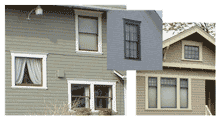The style of windows and pattern of openings in a building is one of the single most important elements in defining its character and the date of construction. Retaining and celebrating authenticity applies to windows, too. Replacement windows, no matter how accurate, never reflect the nuances of the original.
 In a short walk in the historic neighborhoods in the downtown area, you will find an incredible variety of different window styles. Early wood windows were characterized by the small panes. As the sash thickness increased by the turn of the century, muntins took on a thinner appearance as they narrowed in width but increased in thickness. Changes in technology led to the possibility of larger glass panes so that by the mid-19th century, four-over four and two-over-two lights were common – but then gave way to the one-over-one sashes by the 20th century. Arts and Crafts houses constructed in the 20th century frequently utilized smaller lights in the upper sash set in groups or pairs and saw the re-emergence of casement windows.
In a short walk in the historic neighborhoods in the downtown area, you will find an incredible variety of different window styles. Early wood windows were characterized by the small panes. As the sash thickness increased by the turn of the century, muntins took on a thinner appearance as they narrowed in width but increased in thickness. Changes in technology led to the possibility of larger glass panes so that by the mid-19th century, four-over four and two-over-two lights were common – but then gave way to the one-over-one sashes by the 20th century. Arts and Crafts houses constructed in the 20th century frequently utilized smaller lights in the upper sash set in groups or pairs and saw the re-emergence of casement windows.
Please visit the following links and download brochures related to historic windows.
- Standards for Substitute Materials for Windows are found in the Albany Development Code Article 7.
- Guidelines for Sustainability and Historic Windows (from the Secretary of the Interior’s Standards for Rehabilitation)
- Evaluating Historic Windows for Repair or Replacement (NPS Technical Preservation Services)
- Documentation Requirements for Proposed Window Replacement
- www.kshs.org/resource/windowrepair.htm - Site has how-to videos on window repair
- www.HistoricHomeWorks.com – the window repair guru
- Preservation Brief # 9, The Repair of Historic Wooden Windows
- Thermal Performance of Repaired and Replaced Windows (pdf)
- Constructing Wood Storm Windows
- Ten Reasons to Repair Your Windows (pdf)
- Why Say No to Vinyl Windows (pdf)
- Why Say No to Vinyl Windows – Daily Journal of Commerce article (pdf)
- Improving Energy Efficiency in Historic Buildings (Technical Preservation Brief from NPS)
NOTE: The City of Albany’s Code requires historic windows to be repaired first. Deterioration needs to include extensive dry-rot such that a sharp object substantially penetrates the wood in numerous locations. Staff must first come out and inspect the condition of windows to document deterioration. If the deteriorated parts of windows cannot be economically repaired then new wood (interior/exterior) replacement parts sashes and sills only that match the original in all details is the next option. New WOOD windows require staff level historic review to ensure that the new window sashes duplicate the original window.
Repairing windows is cost effective and sustainable:
- Repairing original sash and parts saves the embodied energy used to produce the windows originally and the energy it takes to make new windows.
- Repairing windows is inexpensive for do-it yourselfers. If you are unable to make repairs yourself or with help from a neighbor, hiring out repairs employs someone locally.
NOTE: Replacing non-original metal, vinyl or other windows is encouraged, but requires a staff level historic review.
If new wood windows are cost prohibitive, then non-wood replacement windows may be considered through the historic review process and approval must be granted by the Landmarks Commission. See the Code standards below.
ADC 7.200. Eligibility for the Use of Substitute Materials. The City of Albany interprets the Secretary of Interior’s Standards for Rehabilitation on compatibility to allow substitute for windows only under the following conditions:
(1) The building or structure is rated historic non-contributing OR, in the case of historic- contributing buildings or structures, the existing windows are so deteriorated or damaged that they cannot be repaired and finding materials that would match the original windows is cost prohibitive.
For buildings or structures rated historic contributing or historic non-contributing, the application for the use of substitute materials for windows must follow these guidelines (7.210):
(1) The proposed substitute materials must approximate in placement, profile, size, proportion, and general appearance the existing windows.
(2) Substitute windows must be installed in a manner that maximizes the ability of a future property owner to remove the substitute materials and restore the structure to its original condition using traditional materials.
(3) The proposed material must be finished in a color appropriate to the age and style of the house, and the character of both the streetscape and the overall district.
(4) The proposed windows must not damage, destroy, or otherwise affect decorative or character-defining features of the building. Unusual examples of historic windows may not be covered or replaced with substitute materials.
(5) The covering of existing historic wood window or door trim with substitute trim will not be allowed if the historic trim can be reasonably repaired. Repairs may be made with fiberglass or epoxy materials to bring the surface to the original profile, which can then be finished, like the original material.


